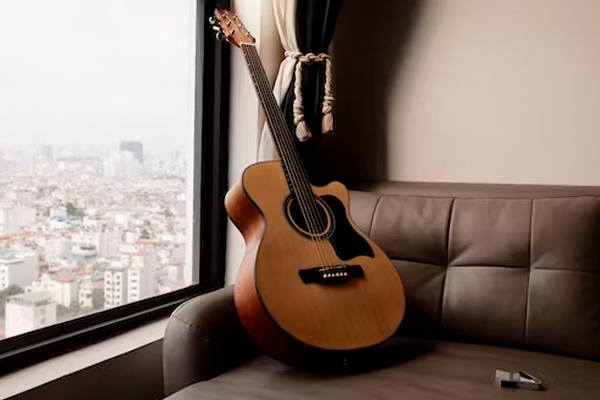
“How to Tune Classical Guitar: A Guide for Beginners and Pros Tuning is a crucial skill for all guitarists, ensuring beautiful melodies. In this guide, discover the tools, methods, and tips for effective classical guitar tuning.
I highly recommend you tune every time you play the guitar but beginners can also have an electronic tuner around for accuracy after they try tuning by ear. At some point, if you’re playing guitar you must learn how to tune your guitar strings by ear. You can also tune your guitar using harmonics. This method is similar to the above method in that you tune one string to another, and that to the next. Tuning using harmonics also assumes that your classical guitar’s intonation is perfect and this may not be true.
How to tune a classical guitar by ear or with an electronic tuner – In this lesson I’ll cover various ways to tune your guitar as well as outline tuning priorities for beginners to more advanced players. Tuning is a skill that must be practiced like any skill. Here’s a tip: intentionally get your guitar out of tune and then begin tuning to one string. Go here for a comprehensive guide on how to tune by ear, how to tune with an electronic tuner and much more. So we’re going to take a look at how to tune the guitar.
Table of Contents
Necessary Tools for Tuning a Guitar
One of the simplest ways to tune a classical guitar involves relying on your ear. Tuning methods that use octaves, digital tuners, tuning apps, and digital keyboards are very good. For beginners, a portable or online tuner is a suitable option. This software can be accessed on any device with a microphone, making tuning convenient and adaptable to any environment. The portable tuner is compact and easy to carry around, featuring a screen that displays a scale.
As you pluck the strings, the device measures the accuracy of their sound: if a string is too tight, the scale will tilt to the right, and if it’s too loose, it will tilt to the left. There are various ways to tune your guitar – by ear or using a tuner – whichever method works best for you. As time goes on, your ear will become more attuned to the small differences in pitch, and you’ll find getting your guitar properly in tune will become easier and easier.
Tuning can also be executed using a tuning fork, a portable tool reproducing a sound of the desired pitch. A standard tuning fork emits the “A” note of the first octave with a frequency of 440 Hz. For tuning a guitar, a tuning fork emitting the “E” note, serving as a reference sound for the first string, is recommended. Initially, the musician tunes the first string to the tuning fork, subsequently harmonizing the remaining strings to match its resonance.
How to Tune Classical Guitar?
Each of the six strings of your guitar is a different thickness with string 6 being the thickest and string 1 the thinnest. When it comes to tuning a classical guitar, using an electronic tuner is not only one of the most common methods but also highly accurate. To help you with this process, here’s a step-by-step guide on how to use an electronic tuner to tune your guitar:
- Choose the Right Electronic Tuner: It’s important to select an electronic tuner that is specifically designed for classical guitars. Most tuners offer various instrument settings, so be sure to set yours to either “guitar” or “classical guitar” mode.
- Power Up Your Tuner: Before getting started, make sure your electronic tuner is powered up and ready for use. If it requires batteries, ensure they are installed and working properly. Additionally, if there’s an on/off switch, turn it on.
- Clip or Position the Tuner: For clip-on tuners, attach the tuner to the headstock of your classical guitar. Ensure a secure grip that doesn’t interfere with the strings or your playing. If using a pedal tuner, connect it appropriately to your guitar setup.
- Pluck Each String: Begin with the low E string (the thickest string) and pluck it gently. Observe the tuner display, which will indicate whether the pitch is too high, too low, or in tune.
- Adjust the Tuning Peg: If the tuner indicates the pitch is off, turn the corresponding tuning peg. If the pitch is too low, tighten the string by turning the peg clockwise. If it’s too high, loosen the string by turning the peg counterclockwise.
- Repeat for Each String: Progress through each string, following the same process. Tune each string according to the standard tuning: E, A, D, G, B, E.
- Double-Check: After tuning all strings, go back and double-check each one. Strings can affect each other, so fine-tuning may be necessary after adjusting multiple strings.
- Ensure Stability: Once all strings are in tune, play a few chords or notes to ensure stability. If any strings seem to drift out of tune quickly, recheck and adjust as needed.
Why It Is Important to Stretch the Strings Before Tuning Them?

Image by Maxime Favier from Unplash
We’ll start from the basics and work up to more advanced tuning concepts. The first thing to know about tuning on the guitar is that it’s a somewhat complex matter. It’s also not something we can do perfectly. Before fine-tuning your instrument, it is crucial to delicately stretch the strings. This important step helps stabilize the tension, resulting in a more precise and enduring tuning. Additionally, stretching minimizes the likelihood of the strings slipping out of tune shortly after tuning.
To effectively stretch the strings, gently pull on each one along its length while applying slight pressure. It is important to exercise caution and avoid excessive force that could potentially damage the strings. Stretch each string individually, and then play each one open to aid in settling the tension further.
By following this method of stretching and tuning, you can ensure that each fret and open string produces an accurate sound when you turn the tuning pegs. This will ultimately enhance your ability to play chords smoothly and effortlessly with complete control over each string’s pitch.
Do You Tune a Classical Guitar Differently?
Tuning a classical guitar shares the same foundational principles as tuning other types of guitars, but there are nuances to consider due to the unique characteristics of classical guitars, particularly their use of nylon strings. Here’s a closer look at how tuning a classical guitar may differ:
- Nylon Strings: Classical guitars typically feature nylon strings or a combination of nylon and wound strings, as opposed to the all-steel strings found on many acoustic and electric guitars. The elasticity and characteristics of nylon strings mean they respond differently to tension adjustments compared to steel strings.
- Tuning Pitch: The standard tuning for a classical guitar is usually the same as that of a standard acoustic guitar: E4, A3, D3, G2, B2, E2 (from low to high). However, due to the nature of nylon strings, achieving and maintaining pitch can be a bit different. Nylon strings may take longer to settle into a stable pitch compared to steel strings.
- Gentle Tuning: When tuning a classical guitar, it’s advisable to be gentle with the tuning pegs. Nylon strings can be more sensitive to abrupt changes in tension, so turning the tuning pegs slowly and carefully is key to achieving the desired pitch without putting undue stress on the strings.
- Use the tuning fork: To begin tuning simply strike your tuning fork on a hard surface, and place the extremity (not the fork) against the body of the guitar which will resonate the sound. Play string 5 open and adjust the tuning peg until the sound of the string is the same as the sound of the tuning fork.
- More Frequent Tuning: Nylon strings are known for their stability, but they may require more frequent tuning compared to steel strings, especially when they are relatively new. It’s not uncommon for classical guitarists to perform small tuning adjustments before each playing session.
- Tuning to One Reference String: In this method, you use one reference string to tune all the strings. I like to use the 5th string (A) because I tune the A string to the tuning fork or reference pitch of a metronome.
- Tuning with Harmonics: This method of tuning can be very accurate as you’ll be able to hear both strings at the same time which makes pitch matching much easier. It’s also great because both strings will sound without you having to fret a note and so your hands are free to turn the pegs.
- Reference Note and Octaves: One advantage to this method is that if you know that your initial note is relatively in tune (because you tuned it to tuner/app, or another instrument, etc), you can reasonably assume that each other note will be in tune once it’s matched to this one.
- Ear Tuning: Tuning your guitar “by ear” simply means that you listen carefully and adjust according to what you hear, instead of using a guitar tuner app or chromatic tuner. Some classical guitarists prefer to tune their instruments by ear, relying on their sense of pitch rather than using electronic tuners. It is essential to learn to tune by ear but I don’t know many pros that don’t have a tuner around. Sometimes you need quick tuning accurate to A 440hz. This method allows for a more nuanced and personal tuning experience, as the player adjusts the strings to their preferred tonal qualities. You can relax your face – we hear better with a relaxed jaw. You can put your attention on feeling the nylon strings and hearing the guitar sounds. This focused awareness will lead to a better overall classical guitar practice.
Can You Drop Tune a Classical Guitar?
Drop tuning involves lowering the pitch of one or more strings on a guitar, a practice often linked with electric guitars. While drop tuning can be applied to classical guitars, it’s essential to recognize that it may exert extra stress on the guitar’s neck, potentially affecting intonation and playability. For those intrigued by drop tuning on a classical guitar, seeking guidance from a professional guitar technician or luthier is recommended. Their expertise can assess your instrument’s condition and implement necessary adjustments for optimal performance in alternate tunings.
What is the Tuning for a 7 String Classical Guitar?
A 7-string classical guitar provides an extended range, allowing guitarists to explore a wider tonal palette. The additional string is typically tuned to a lower pitch, providing a deeper bass note. The most common tuning for a 7-string classical guitar is as follows:
- 7th string (low B): B
- 6th string (low E): E
- 5th string (A): A
- 4th string (D): D
- 3rd string (G): G
- 2nd string (B): B
- 1st string (high E): E
With the added low B string, a 7-string classical guitar offers expanded possibilities for chord voicings, bass lines, and melodic phrases.
How Often Should I Tune My Classical Guitar?

Image by Edgar from Unplash
Regular tuning is paramount to preserving the integrity of your guitar’s sound. External factors such as temperature and playing frequency can influence string tension, making it advisable to tune your classical guitar each time you play for optimal performance.
Tips
- Utilize harmonics for more precise tuning.
- Consider the length of the string; shorter strings typically require higher tension.
- Cross-check your tuning against fretted notes, particularly in the first position.
- One very popular method for tuning on the guitar is to play the 5th fret harmonic on one string and to try and match the 7th fret harmonic of the adjacent higher string.
- Knowing how to tune a guitar properly is one of the best ways to ensure that you sound good. Using a digital tuner, any guitar tuner will likely work.
- Once you have the guitar tuned anyway, it will sound better.
- The higher the tension, the higher the pitch. The length of the vibrating portion of the string is adjusted by using the fingers (usually of the left hand) to hold down the string until it is in contact with a fret.
- Tuning by natural harmonics is the simplest way to tune your guitar by ear.
- If you do everything right tuning your guitar and it still won’t play in tune, you may need to try another method. You want to change your strings, or take your classical guitar to a technician and let them take a look.
- Many electronic metronomes include an A 440hz reference pitch for tuning as an extra feature which you can use to tune just as with the tuning fork.
- Tuning forks are great for getting one string in tune as a reference pitch.
- Depending on how far your guitar is out of tune, make two or more passes through the tuning process.
- You can tune the 5th string A to the tuning fork and use any method of tuning. If using string-to-string simply tune the 6th string A at fret of the fifth string to the tuning fork as well.
- You could use one string to play the various pitches of the open strings and then match the pitch in unison or octave.
- The first and most important thing to note about tuning is to use your ear. Listen to the sounds of pitches that are in tune and those that are even slightly out of tune. This comes with experience and, yes, practice.
- To tune the first string, first play the harmonic on the 7th fret of the fifth string. This note is the matching pitch of the open first string (no harmonic, just the open string).
Warnings
- Exercise caution to prevent over-tightening strings, which could lead to damage.
- Be mindful of sudden changes in temperature and humidity, as they can impact tuning; store your guitar appropriately.
- If you tune one of the strings and hear an increase in the speed of the beats you are going the wrong way. As you turn the tuning key the other way the beats will slow down and eventually stop completely when the two notes are perfectly in tune.
- Too much finger pressure on fretted notes can cause problems in tuning. The guitar is intonated to produce the correct pitch when the string is pressed down to touch the fret wire. If you press harder than that and press the string to the wood of the fretboard or close to it, the note will be sharp.
- You should always tune upwards in tone, not downwards.
- In equal temperament tuning, the 3rd and 7th fret harmonics are slightly sharp and the 4th and 9th fret harmonics are very flat. Therefore, do not use 3rd, 4th, 7th, or 9th fret harmonics to tune your guitar. Yes, 7th-fret harmonics are out of tune!
- Strings that are next to each other might be fairly in tune but strings far away might be quite out of tune.
- Even brand new out-of-the-package strings can be defective. Any deviation in diameter or material properties along the string length, or rough spots on the string surface will cause a string to play out of tune in some areas of the fretboard. It is usually especially noticeable at the octave.
- Unfortunately, there is another source of beats, even in a perfectly tuned unison. For example, the 6th string A at the 5th fret might be in perfect unison with the 5th string open A, yet still produce audible beats. The reason is that the strings are not vibrating independently.
- As you progress from one pair of strings to the next, any slight error in tuning is propagated to the next string. If you are just slightly off with the first or second pair of strings, the error compounds as you proceed.
- You should always tune up to pitch, and not down to it. Otherwise, the tension in the strings can cause the gears to wind back ever so slightly.
Conclusion
Tuning a classical guitar is an art that every guitarist must master. Whether using an electronic tuner, tuning fork, or your ear, the goal is to get your guitar in tune and keep it there. Remember the tips and warnings, and soon you’ll be playing your classical guitar in perfect harmony. All the methods above have various pros and cons and even electronic tuners or apps can be slightly off sometimes. Therefore, it is always a good idea to play a few chords to check your tuning.
Chords in first position that use all six strings are preferable. Finally, if none of the above works for you: it is okay to use a tuner. Using an electronic tuner is likely to be one of the most accurate methods of tuning for equal temperament. While twenty years ago electronic tuners weren’t known for being accurate, their accuracy has vastly improved. Happy tuning!






